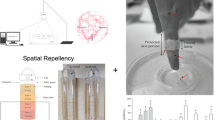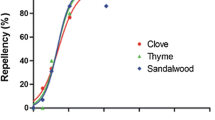Abstract
The spread of blacklegged ticks (Ixodes scapularis) and growing threat of Lyme disease transmission has increased demand for effective, safe and environmentally friendly repellent products. Plant-derived essential oils are natural products that exhibit insecticidal and repellant activities and represent a promising alternative to synthetic repellants. However, mechanisms by which ticks detect odor stimuli and how such stimuli may function as repellents are not well understood. We examined the repellent activity of selected essential oil components towards I. scapularis in short- and long-term dose–response trials. To determine the specific olfactory organs involved in detection of chemical stimuli, we tested tick behavioral response in repellency bioassays after removing appendages that house chemosensory sensilla (e.g., foretarsi or pedipalps). New prototype formulae were tested in longevity trials repelling up to 95% of tested ticks after 1 h post-application. This study provides new insight regarding tick olfaction and behavior, and innovative methods for selecting appropriate chemicals for development of novel plant-based repellent products for protection from ticks.



Similar content being viewed by others
References
Abdel-Ghaffar F, Al-Quraishy S, Mehlhorn H (2015) Length of Tick repellency depends on formulation of the repellent compound (icaridin = Saltidin®): test on Ixodes persulcatus and Ixodes ricinus placed on hands and clothes. Parasitol Res 114:3041–3045
Anderson JF, Magnarelli LA (2008) Biology of ticks biology of ticks. Infect Dis Clin North Am 22:195–215
Benelli G, Pavela R (2018) Repellence of essential oils and selected compounds against ticks—a systematic review. Acta Trop 179:47–54
Benelli G, Pavela R, Canale A, Mehlhorn H (2016) Tick repellents and acaricides of botanical origin: a green roadmap to control tick-born disease? Parasitol Res 115:2545–2560
Bissinger WB, Roe RM (2010) Tick repellent: past, present, and future. Pestic Biochem Phys 96:63–79
Bissinger WB, Roe RM (2014) Tick repellent research methods and development. In: Sonenshine DE, Roe RM (eds) Biology of ticks, vol 2. Oxford University Press, New York, pp 382–408
Bissinger BW, Schmidt JP, Owens JJ, Mitchell SM, Kennedy MK (2014) Activity of the plant-based repellent, TT-4302 against the ticks Amblyomma americanum, Dermacentor variabilis, Ixodes scapularis and Rhipicephalus sanguineus (Acari: Ixodidae). Exp Appl Acarol 62:105–113
Brausch JM, Rand GM (2011) A review of personal care products in the aquatic environment: environmental concentrations and toxicity. Chemosphere 82:1518–1532
Carr AL, Roe M (2016) Acarine attractants: chemoreception, bioassay, chemistry and control. Pestic Biochem Phys 131:60–79
Carr AL, Mitchell RD III, Dhammi A, Bissinger BW, Sonenshine DE, Roe RM (2017) Tick Haller’s organ, a new paradigm for arthropod olfaction: how ticks differ from insects. Int J Mol Sci 18:1563. https://doi.org/10.3390/ijms18071563
Carroll JF, Solberg VB, Klun JA, Kramer M, Debboun M (2004) Comparative activity of deet and AI3-37220 repellents against the ticks Ixodes scapularis and Amblyomma americanum (Acari: Ixodidae) in laboratory bioassays. J Med Entomol 41:249–254
Carroll JF, Klun JA, Debboun M (2005) Repellency of deet and SS220 applied to skin involves olfactory sensing by two species of ticks. Med Vet Entomol 19:101–106
Carroll JF, Tabanca N, Kramer M, Elejalde NM, Wedge DE, Bernier UR, Coy M, Becnel JJ, Demirci B, Baser KHC, Zhang J, Zhang S (2011) Essential oils of Cupressus funebris, Juniperus communis, and J. chinensis (Cupressaceae) as repellents against ticks (Acari: Ixodidae) and mosquitoes (Diptera: Culicidae) and as toxicants against mosquitoes. J Vector Ecol 36:258–268
Chen W, Viljoen AM (2010) Geraniol—a review of a commercially important fragrance material. S Afr J Bot 76:643–651
de Bruyne M, Guerin PM (1998) Contact chemostimuli in the mating behaviour of the cattle tick, Boophilus microplus. Arch Insect Biochem 39:65–80
Del Fabbro S, Nazzi F (2013) From chemistry to behavior Molecular structure and bioactivity of repellents against Ixodes ricinus ticks. PLoS ONE. https://doi.org/10.1371/journal.pone.0067832
Eisen RJ, Eisen L (2018) The blacklegged tick, Ixodes scapularis: and increasing public health concern. Trends Parasitol 34:295–309
Falco RC, Fish D (1991) Horizontal movement of adult Ixodes dammini (Acari: Ixodidae) attracted to CO2-baited traps. J Med Entomol 28:726–729
Fernandes Soares S, Ferreira Borges LM, de Sousa Braga R, Lopes Ferreira L, Braz Louly CC, Tresvenzol LMF, de Paula JR, Ferri PH (2010) Repellent activity of plant-derived compounds against Amblyomma cajennese (Acari: Ixodidae) nymphs. Vet Parasitol 167:67–73
Ferreira LL, de Oliveira Filho J, Moura Mascarin G, Pérez de León A, Ferreira Borges LM (2017) In vitro repellency of DEET and beta-citronellol against the ticks Rhipicephalus sanguineus sensu latu and Amblyomma sculptum. Vet Parasitol 239:42–45
Foelix RF, Chu-Wang IW (1972) Fine structural analysis of palpal receptors in the tick Amblyomma americanum (L.). Zeitschrift für Zellforschung und Mikroskopische Anatomie 129:548–560
Gross AD, Coats JR (2015) Can green chemistry provide effective repellents? In: Debboun M, Frances S, Strickman D (eds) Insect repellents handbook. CRC Press, Boca Raton, pp 75–90
Lalko J, Api AM (2006) Investigation of dermal sensitization potential of various essential oils in the local lymph node assay. Food Chem Toxicol 44:739–746
Lee MY (2018) Essential oils as repellents against arthropods. Biomed Res Int. https://doi.org/10.1155/2018/6860271
Moore SJ, Lenglet A, Hill N (2007) Plant-based insect repellents. In: Debboun M, Frances S, Strickman D (eds) Insect repellents: principles, methods, and uses. CRC Press, Boca Raton, pp 305–310
Müller GC, Junnila A, Butler J, Kravchenko VD, Revay EE, Weiss RW, Schlein Y (2009) Efficacy of the botanical repellents geraniol, linalool, and citronella against mosquitoes. J Vector Ecol 34:2–8
Nerio LS, Olivero-Verbel J, Stashenko E (2010) Repellent activity of essential oils: a review. Bioresour Technol 101:372–378
Nijkamp MM, Bokkers BGH, Bakker MI, Ezendam J, Delmaar JE (2015) Quantitative risk assessment of the aggregate dermal exposure to the sensitizing fragrance geraniol in personal care products and household cleaning agents. Regul Toxicol Pharm 73:9–18
Ogden NH, Brigas-Poulin M, Hanincová K, Maarouf A, O’Callaghan CJ, Kurtenbach K (2008a) Projected effects of climate change on tick phenology and fitness of pathogens transmitted by the North American tick Ixodes scapularis. J Theor Biol 254:621–632
Ogden NH, Phil D, Lindsay LR, Morshed M, Sockett PN, Artsob H (2008b) The rising challenge of Lyme borreliosis in Canada. Can Commun Dis Rep 34:1–19
Phillips JS, Sonenshine DE (1993) Role of the male claw sensilla in the perception of female mounting sex pheromone in Dermacentor variabilis, Dermacentor andersoni and Amblyomma americanum. Exp Appl Acarol 17:631–653
Piesman J, Dolan MC (2002) Protection against Lyme disease spirochete transmission provided by prompt removal of nymphal Ixodes scapularis (Acari: Ixodidae). J Med Entomol 39:509–512
Politano VT, Diener RM, Christian MS, Hawkins DR, Ritacco G, Api AM (2013a) The pharmacokinetics of phenylethyl alcohol (PEA) safety evaluation comparisons in rats, rabbits, and humans. Int J Toxicol 32:39–47
Politano VT, Diener RM, Christian MS, Hoberman AM, Palmer A, Ritacco G, Adams TB, Api AM (2013b) Oral and dermal developmental toxicity studies of phenylethyl alcohol in rats. Int J Toxicol 32:32–38
Renthal R, Manghnani L, Bernal S, Qu Y, Griffith WP, Lohmeyer K, Guerrero FD, Borges LMF, Pérez de León A (2017) The chemosensory appendage proteome of Amblyomma americanum (Acari: Ixodidae) reveals putative odorant-binding and other chemoreception-related proteins. Insect Sci 24:730–742
Ripoche M, Gasmi S, Adam-Poupart A, Koffi JK, Lindsay LR, Ludwing A, Milord F, Ogden NH, Thivierge K, Leighton PA (2018) Passive tick surveillance provides an accurate early signal of emerging Lyme disease risk and human cases in Southern Canada. J Med Entomol 55:1016–1026
RStudio Team (2018) RStudio: integrated development for R. RStudio, R. Boston (MA). https://www.rstudio.com
Scognamiglio J, Jones L, Letizia CS, Api AM (2012) Fragrance material review on phenylethyl alcohol. Food Chem Toxicol 50:S224–S239
Showler AT, Harlien JL (2017) Botanical compound p-anisaldehyde repels larval lone star tick (Acari: Ixodidae), and halts reproduction by gravid adults. J Med Entomol. https://doi.org/10.1093/jme/tjx158
Šimo L, Sonenshine DE, Park Y, Zitnan D (2013) Nervous and sensory systems: structure, genomics and proteomics. In: Sonenhine DE, Roe M (eds) Biology of ticks, vol 1. Oxford University Press, New York, pp 309–367
Snydman DR (2017) Lyme disease. Medicine 45:734–746
Soares SF, Borges LMF (2012) Electrophysiological responses of the olfactory receptors of the tick Amblyomma cajennense (Acari: Ixodidae) to host-related and tick pheromone-related synthetic compounds. Acta tropica 124:192–198
Soares SF, Louly CCB, Marion-Poll F, Ribeiro MFB, Borges LMF (2013) Study on cheliceral sensilla of the brown dog tick Rhipicephalus sanguineus (Latreille, 1806) (Acari: Ixodidae) involved in taste perception of phagostimulants. Acta Trop 126:75–83
Sridharan TB, Prakash S, Chauhan RS, Rao KM, Singh K, Singh RN (1998) Sensilla on the palps and legs of the adult soft tick Argas persicus Oken (Ixodoidea: Argasidae) and their projections to the central nervous system. Int J Insect Morph Embryol 27:273–289
Stafford KC III, Williams SC, Molaei G (2017) Integrated pest management in controlling ticks and tick-associated diseases. J Int Pest Manag 8:1–7
Tabanca N, Wang M, Avonto C, Chittiboyina AG, Parcher JF, Carroll JF, Kramer M, Khan IA (2013) Bioactivity-guided investigation of geranium essential oils as natural tick repellents. J Agric Food Chem 61:4101–4107
Tak JH, Jovel E, Isman MB (2017) Synergistic interactions among the major constituents of lemongrass essential oil against larvae and an ovarian cell line of the cabbage looper, Trichoplusia ni. J Pest Sci 90:735–744
Thorsell W, Mikiver A, Tunón H (2006) Repelling properties of some plant materials on the tick Ixodes ricinus L. Phytomed 13:132–134
Tisserand R, Young R (2013) Essential oil safety-E-Book: a guide for health care professionals. Elsevier, Amsterdam
Tunón H, Thorsell W, Mikiver A, Malander I (2006) Arthropod repellency, especially tick (Ixodes Ricinus), exerted by extract from Artemisia Abrotanum and essential oil from flowers of Dianthus Caryophyllum. Fitoterapia 77:257–261
Waladde SM, Rice MJ (1982) The sensory basis of tick feeding behavior. In: Obenchain FD, Galun R (eds) Physiology of ticks, current themes in tropical science. Elsevier, Amsterdam
Weldon PJ, Carroll JF, Kramer M, Bedoukian RH, Coleman RE, Bernier UR (2011) Anointing chemicals and hematophagous arthropods: responses by ticks and mosquitoes to citrus (Rutaceae) peel exudates and monoterpene components. J Chem Ecol 37:348–359
White A, Gaff H (2018) Review: application of tick control technologies for blacklegged, lone star, and American dog ticks. J Integr Pest Manag 12:1–10
Zhu JJ, Cermak SC, Kenar JA, Brewer G, Haynes KF, Boxler D, Baker PD, Wang D et al (2018) Better than DEET repellent compounds derived from coconut oil. Sci Rep 8:14053. https://doi.org/10.1038/s41598-018-32373-7
Acknowledgements
We would like to thank Wendy Hillier and Angie Moore for technical assistance and data collection. We thank Atlantick® Repellent Products for technical support. Special thanks to two anonymous reviewers for their constructive comments and support. This research project was funded by the Canadian Lyme Disease Foundation (CanLyme, Venture Grant to NF), Productivity & Innovation Voucher Grant (Nova Scotia) (to NF), and NSERC Discovery funding (RGPIN-2017-04319 to NKH).
Author information
Authors and Affiliations
Contributions
NF, SM, and NKH conceived and designed research. NF and SM conducted the experiments. NF analyzed data. NF, SM, and NKH wrote the manuscript. All authors read and approved the manuscript.
Corresponding author
Additional information
Publisher's Note
Springer Nature remains neutral with regard to jurisdictional claims in published maps and institutional affiliations.
Rights and permissions
About this article
Cite this article
Faraone, N., MacPherson, S. & Hillier, N.K. Behavioral responses of Ixodes scapularis tick to natural products: development of novel repellents. Exp Appl Acarol 79, 195–207 (2019). https://doi.org/10.1007/s10493-019-00421-0
Received:
Accepted:
Published:
Issue Date:
DOI: https://doi.org/10.1007/s10493-019-00421-0




